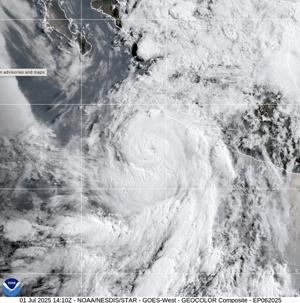Hurricane Flossie has intensified into a formidable Category 3 cyclone, currently positioned off Mexico’s Pacific coast, prompting heightened vigilance from meteorological agencies and coastal communities. This significant escalation underscores the dynamic and unpredictable nature of the current weather season, as the storm rapidly gained strength in recent hours. While its core remains offshore, its growing power raises immediate concerns for maritime operations and nearby land areas along the vast Pacific shoreline.
The designation of Flossie as a Category 3 hurricane signifies sustained wind speeds reaching between 111-129 mph (178-208 km/h), transforming it into a substantial natural disaster threat. Its current trajectory maintains it off the Mexican coast, yet the sheer force of its winds and the potential for powerful swells and rip currents cannot be underestimated. This development highlights the inherent dangers posed by such weather phenomena to both shipping lanes and coastal ecosystems.
Weather agencies, including local Mexican authorities and international forecasting centers, are rigorously monitoring Flossie’s every move. Their continuous tracking involves analyzing its trajectory, atmospheric pressure changes, and intensity fluctuations to provide real-time advisories. These updates are crucial for ensuring public safety and facilitating proactive measures, illustrating the collaborative effort required in managing large-scale natural disasters.
The heightened strength of Hurricane Flossie inherently poses a substantial threat, particularly if there’s any shift towards landfall or if its offshore disturbances become more severe. Residents and visitors along Mexico’s Pacific coastline are urged to heed official warnings without delay. Preparedness, including staying informed through reliable weather sources and implementing emergency protocols, is paramount to mitigating potential risks from this powerful hurricane.
The ongoing vigilance by national and international meteorological bodies is geared towards mitigating potential risks, protecting lives, and safeguarding infrastructure. Timely information dissemination is critical for effective disaster response and planning in potentially affected areas. This incident serves as a stark reminder of the need for continuous public awareness and caution when confronting the raw power of such significant weather events.
While Flossie’s immediate path keeps it offshore, the erratic behavior of hurricanes during peak season demands sustained attention. The long-term implications of intense storms like this for the region’s infrastructure, tourism, and marine life necessitate comprehensive strategies for resilience and adaptation to future climatic challenges along the Pacific coast.
Discover more from The Time News
Subscribe to get the latest posts sent to your email.






